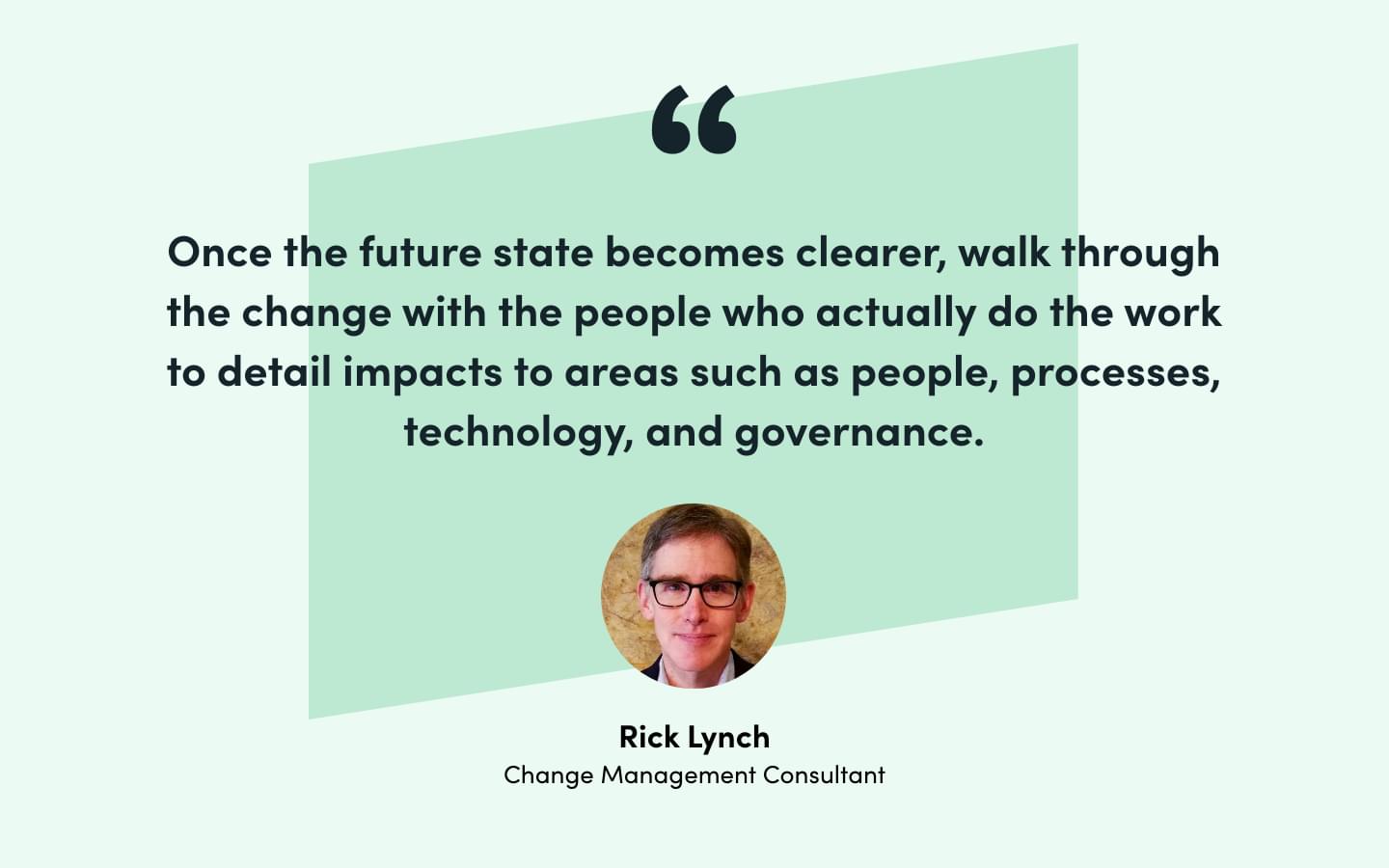Humans are creatures of habit.
But it’s not that we simply choose to be this way—we’re actually physiologically wired to resist change.
A section of our brain called the amygdala can interpret change as a threat. When triggered, it releases hormones that direct your body into fear, fight, or flight mode.
Now, I’m not trying to give us all an easy out and reason to avoid change. But it helps to paint the picture of why managing change is so hard sometimes. When you pair this engrained resistance to change with the mix of personality traits, biases, beliefs, and assumptions within an organization, it’s no wonder that 70% of change efforts fail.
Yet that change statistic means 30% of organizational change efforts succeed. What strategies make these efforts work? Are there change management steps that can help ensure you’re in the 30% instead of the 70%? Change Management Expert and Consultant Rick Lynch believes so.
Below, he shares insights about change management from his extensive consulting work that has supported some of the world’s largest organizations in industries such as healthcare, government services, and technology. Let’s dive in.
What is change management?
Change management helps ensure that organizations engage employees and other stakeholders throughout the change process. Employees are essential to the success of a change, yet organizations become busy with program management and technical aspects and fail to adequately involve the people who do the work and know it best.
All too often I hear phrases like “no one ever tells us anything” and “if they had asked me, I could have told them.”
A study by Towers Watson found that only 53% of middle managers reported understanding the reasons for major organizational changes. Not surprisingly, only 55% of the initiatives achieved desired objectives, and only about 25% experienced lasting gains.
With effective change management, instead of employees being frustrated, disempowered, and surprised by a change, team members are actively involved in improving how the change will work and preparing for success.

The pace of change in the world around us continues to accelerate, and forward-thinking companies are turning to internal change management teams and consultants to build the organizational capacity to change and stay ahead of the competition.
Why do people resist change?
Lack of awareness: How we communicate the change matters. If the change isn’t important enough to explain the reasons behind it, why should employees care and why should they make the effort? When possible, sprinkle hints in advance about the need for change and invite interested employees into the planning process.
Attachment to the present: Employees are also inherently more comfortable with the current ways of doing things. Team members may be highly respected for developing or mastering the old way and concerned that the new way will be difficult. Be sure to celebrate past accomplishments and provide reassurances that there will be ample training, support, and time to learn the new way.
Too busy: Team members are caught up in meeting the needs of their daily work and may be facing multiple change initiatives, so sometimes they feel they don’t have the time to engage with the change. Find ways to make it easier to change and make sure busy managers are setting an example by actively supporting the change.
Companies resist change too: Kodak, Blockbuster, MySpace, Nokia, and Toys R Us are a few famous examples or organizations that ignored or resisted change until it was too late. In a rapidly changing world, the biggest risk for companies and employees is that they do not change fast enough and become irrelevant in the marketplace.
Diagnosing the reasons for resistance provides the basis for solutions. Try to anticipate sources of resistance so you can be prepared and engage with your team so you can discover additional concerns to address.

What are the change management steps?
Each change is different, so it’s helpful to be familiar with different approaches, such as Dr. Kotter’s methodology for leading change and Prosci’s research-based framework for change management. This allows customizing the change management plan to fit the size, complexity, and type of change, such as mergers and acquisitions, IT transformations, new corporate initiatives, etc. Here are the main steps I typically use:
1. Make the Case for Change
I start by collaborating with key leaders to create a briefing to explain the importance of the change, and in general, what needs to be done, how it will be achieved, and the broad benefits for customers, employees, suppliers, and/or the business. This dialogue is also helpful in recruiting sponsors who will provide the senior leadership influence, support, and resources required for the change.
2. Complete a Stakeholder Analysis
Stakeholders include the senior leaders, sponsors, key individuals, and groups that will be impacted or might have a role to play or interest in the change. Use a spreadsheet to assess each stakeholder’s interests and power as well as to track how their concerns and needs are being addressed.
3. Prepare a Readiness Assessment and Gather Feedback
A change readiness assessment helps determine whether now is the right time for the change and if the proper resources, including committed sponsors and sufficient staffing, are in place to move forward. A separate readiness assessment supports the go/no go decision before launch. Periodic pulse surveys, listening circles, and interviews provide additional insights and identify where more support is needed.
4. Create a High Level Analysis and Change Impact Assessment
Collaborate with subject matter experts to develop high level explanations of the current and future state for each stakeholder group. As the new processes or details of the change are developed, create flow diagrams with swim lanes showing who will do what. Once the future state becomes clearer, walk through the change with the people who actually do the work to detail impacts to areas such as people, processes, technology, and governance.

For each element of the change, discuss how to address communications and training needs in the respective plans, and also note any gaps that will require further discussion and analysis.
5. Build a Change Network
Build a network of sponsors, people managers, and “change champions” who can facilitate two-way communications between their group and those who are leading the change. Consider piloting the change where these network resources are strongest and discuss feedback, assist with answers to questions, and provide coaching.
6. Align on KPIs
Determine key adoption and performance indicators based on desired business outcomes. Be sure to measure progress frequently before and after the change so successes can be celebrated. This helps ensure people are engaged in making the change and continual improvements.
There are usually many unknowns at the beginning of the change process, so revisit these steps periodically to review or add to the list of stakeholders, update impacts, etc.

The Key to Managing Change
One of the first changes a company should make is to develop a strong change management capability. Change, when managed correctly, not only makes the company more successful, but it also gives employees opportunities to develop the strengths in problem solving, inclusion, learning, innovation, and leadership that they’ll need for the future.
And while it is easy for organizations to underestimate the time and leadership needed for effective change, one thing is almost certain: In our fast-changing world, the organizations that develop the greatest capacity for change will be the winners.
If change is the only constant in life, why do so many organizations still find it so daunting? John Kuforiji, an IT project manager, joins us on the Practically Genius podcast to discuss the change management best practices that can transform the culture at your workplace.
About the Author

Rick has more than 20 years of experience helping leaders and global organizations implement technology transformations, mergers and acquisitions, culture change, rebranding, IPOs, and more. His change management work has supported some of the world’s largest organizations in industries such as healthcare, manufacturing, government services, nonprofits, and technology.
Interested in being featured in future Formstack content? Please fill out this form.











